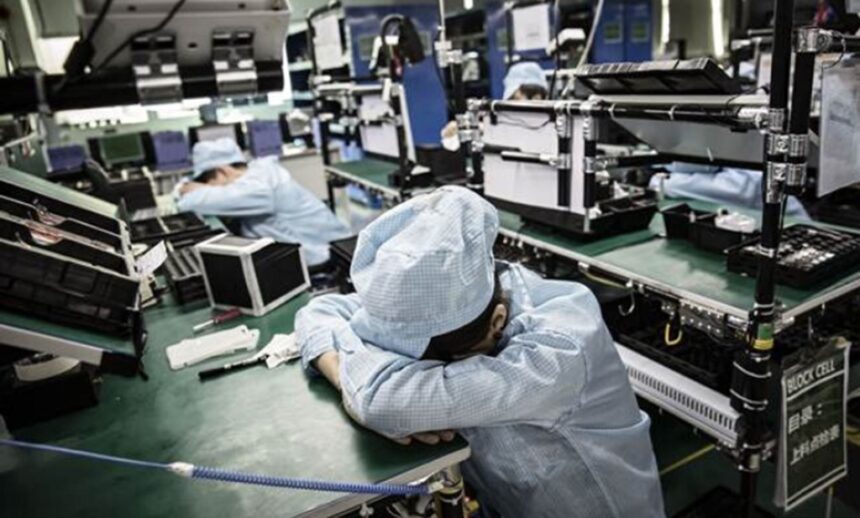BEIJING – China’s economy showed new signs of strain in May 2025 as factory production notched its slowest increase in six months. The country’s efforts to return to pre-pandemic strength are being tested by a sluggish property market, higher unemployment, and uneven export figures. These challenges have left many analysts doubting whether recent government support will be enough to spark a strong recovery.
Figures from the National Bureau of Statistics show industrial output rose 5.8% year-on-year in May, down from 6.1% in April and just under the 5.9% economists predicted. This is the weakest growth since November 2024.
Factories are feeling the pinch from falling prices, fierce competition in sectors like autos, and weak orders for construction materials, all linked to the prolonged real estate downturn.
The Caixin/S&P Global manufacturing PMI slipped to 48.3 in May from 50.4 a month earlier, dropping below the dividing line between growth and contraction for the first time since September 2024.
Manufacturing, a key driver of China’s economy, faces pressure both at home and abroad. On the domestic side, consumer spending remains soft, while the struggling housing market has cut demand for steel and cement. Overseas, trade friction, mainly with the United States, has hurt business confidence.
Tariffs on Chinese goods imported into the US have risen to 51.1%. This has weighed heavily on manufacturers who sell abroad. The Caixin survey showed new export orders at their lowest since July 2023. Zichun Huang of Capital Economics said the recent US-China trade pause did little to prevent a broader slowdown in May.
Worries about stagflation
China’s property sector, once nearly a quarter of GDP, is still stuck in a long slump. Worries about stagflation—a mix of stagnant growth and persistent inflation or falling prices—are growing. New home prices dipped 3.5% compared to May last year. While this is an improvement on the 4% drop in April, it still points to weak buyer interest.
Oversupply is a real issue as well. A former deputy chief at the National Bureau of Statistics said even China’s 1.4 billion people could not fill all the empty flats.
Efforts to revive the housing market have not made much progress. The People’s Bank of China started a new loan programme for affordable housing in April to help shift unsold properties and loosened mortgage requirements.
Still, NBS spokesperson Liu Aihua said the sector is “adjusting” and it will take time for support measures to make a real difference. The property slump has made people less willing to spend. Since property makes up about 70% of household wealth, lower home prices have shrunk net household wealth by 4.3% in 2022, according to Capital Economics. This drop is the first in over 20 years.
Deflation is another worry. April saw the sharpest fall in wholesale prices in six months. While consumer prices edged up by 0.6% in May, ongoing drops in producer prices show continued weak demand and too much capacity, especially in construction.
Ting Lu from Nomura warned that Beijing faces a tough mix of property market troubles and ongoing trade disputes.
China’s Exports Grow
China’s export sector did offer some positive news. Shipments grew 7.6% year-on-year in May, beating forecasts thanks to strong demand from Southeast Asia, which helped offset falling sales to the US.
Still, export growth slowed from April’s 8.1% increase, showing the impact of US tariffs and cooling global demand. The Caixin PMI also showed a drop in new export orders, suggesting tougher times ahead if trade tensions remain.
Steel and aluminium production saw sharp gains in May, fuelled by overseas demand. But analysts warn higher trade barriers could soon slow this trend. ZhaoPeng Xing at ANZ pointed out that strong exports lifted industrial growth, but the weak property sector still hurt consumer spending and investment.
China’s drive for “quality growth” and more self-sufficient technology has boosted manufacturing investment, which rose 9.6% in the first five months of 2024. However, private firms stayed cautious, with investment up just 0.1%.
Unemployment an Issue
Jobs data shows more pressure. The country’s survey-based unemployment rate held at 5.0% in May, the same as April, but did not improve as expected. Youth unemployment is still a big concern, with past figures as high as 20.4% in 2023. The number of new graduates—nearly 12 million in 2024—far outpaces available jobs, especially in tech, which faces tighter government rules.
The property downturn has also cut construction jobs, adding to job market trouble.
Unemployment insurance, first launched in the 1990s, offers some support but mostly helps urban workers. High expectations for young employees, mixed with long work hours, have led to burnout and more stress in the jobs market.
Wang Jun at Zhongyuan Bank said the job situation remains fragile, with both firms and consumers wary of taking on new debt as uncertainty lingers.
China’s leaders have announced several support measures, such as the biggest cut to the five-year loan prime rate since 2019 and a major stimulus package in September 2024. But many analysts doubt these moves will fix deeper problems like oversupply in property and the country’s ageing population.
Goldman Sachs analysts report big differences across sectors. Exports and manufacturing are showing strength while property is lagging. Without bold reforms to boost spending, such as pension changes or birth incentives, growth may stay weak.
The “dual circulation” policy, which aims for stronger local demand and more homegrown technology, faces hurdles from both global trade spats and inefficiencies at home.
Senior Communist Party officials are meeting to discuss these problems. With third-quarter 2024 GDP growth expected at 4.6%, shy of the government’s 5% target, China’s recovery remains uncertain. Weak factory production, a flat housing market, and rising joblessness highlight the economic hurdles that Beijing must address.














